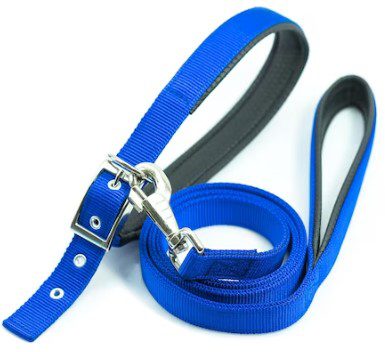

Leash allergy is a common canine allergy that affects dogs when they wear tight collars or leashes. Symptoms of this allergy include red, irritated skin, itchiness, hair loss, and bumps or sores at the area where the collar or leash is worn. In more severe cases, symptoms may include excessive scratching and skin infections.
Leash allergy is caused by an overreaction of the body’s immune system in response to the chemical substances in collar and leash materials, such as nylon, leather, and rubber. Other causes may include repeated friction and heat generated from the collar or leash rubbing against the dog’s skin, as well as contact with other irritants and allergens.
The diagnosis of leash allergy in dogs is made through a physical examination and diagnostic tests such as skin scrapings, bacterial cultures, and/or an intradermal skin test. In some cases, a biopsy of the affected area may be needed to determine the underlying cause of the allergy. Treatment typically involves removing the source of the allergens and prescribing medications, such as steroids or antihistamines, to reduce inflammation.
Leash allergy is a very serious allergic reaction that can cause a variety of uncomfortable and possibly dangerous symptoms. Without treatment, this allergy can increase the risk for bacterial and fungal skin infections, hair loss, and severe discomfort for the dog. The mortality rate for this allergy is low, but it can be dangerous if left untreated.
The primary treatment for leash allergy in dogs is to avoid having them wear tight collars or leashes. If that is not possible, it is important to select collars and leashes that are made of non-allergenic materials. In addition, the area around the collar or leash should be cleaned and monitored for any signs of irritation. If symptoms do not improve after avoidance or cleaning, then your dog should be seen by a veterinary doctor who may prescribe anti-inflammatory medication to reduce the symptoms.
Prevention measures for leash allergy can include wearing a soft, loose-fitting collar or harness instead of a traditional collar and leash, taking frequent breaks and allowing your dog to rest during walks, regularly bathing your dog in a calming or hypoallergenic shampoo, and ensuring your dog’s environment is free of allergens such as dust and pollen. Additionally, it’s important to contact your veterinarian if your dog is exhibiting signs of an allergy. They may be able to provide further advice on managing symptoms, testing, or even prescribing medication.
Leash allergy in dogs is not contagious and cannot be passed on to humans. Symptoms are usually localized to the area where the collar or leash is worn, so it should not cause any issues for other humans or pets. Treatment typically includes medicated shampoos and creams to soothe the skin and prevent further irritation.
For home remedies, it is recommended to use either raw or boiled chicken/turkey/duck neck muscles to help the skin heal, as they contain beneficial fatty acids. Additionally, it is important to always wash your dog’s collar or leash regularly and make sure it isn’t too tight.
Although these home remedies can help to ease the inflammation caused by leash allergies, it is always best to consult with a veterinarian for the best course of action. They will be able to give a diagnosis and prescribe a suitable treatment for your furry friend.
Certain breeds of dogs are more prone to leash allergies than others. Hounds and greyhounds, such as beagles, foxhounds, and harriers, may show signs of an allergic reaction such as itching, irritation, and rashes. In addition, Boxer breed and Bull Terriers may also be vulnerable to this kind of allergy. Other breeds, such as Dalmatians, Pomeranians, Shih Tzus, and Pugs, can also be affected by leash allergies due to their short coats and skin sensitivity. To reduce the risk of leash allergies it is important to clean your dog’s neck and leash often as well as using hypoallergenic fabric.
Have you ever had a dog with a leash allergy? If so, what kind of response did you and your pup have to the allergy? How did you feel about seeing your pup struggle with this? How did you manage it and what kind of treatments did you use? No one should have to watch their pup suffer, and we hope that your pup has found a solution that works and has been able to live a comfortable, healthy life. Wishing you both the best.